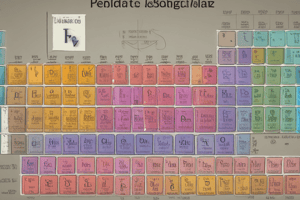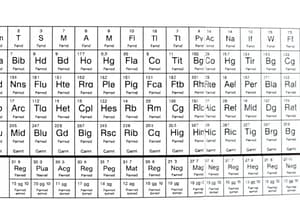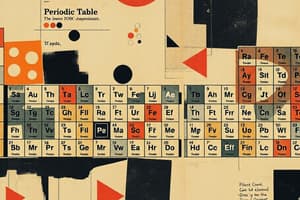Podcast
Questions and Answers
What does periodicity mean?
What does periodicity mean?
Means repeating according to some pattern
What is the periodic law?
What is the periodic law?
States that the physical and chemical properties of elements are periodic functions of their atomic numbers.
What 2 elements combine to make the alloy steel?
What 2 elements combine to make the alloy steel?
Iron and carbon
What are lanthanides?
What are lanthanides?
Who developed the first periodic table?
Who developed the first periodic table?
What is the number of groups on the periodic table?
What is the number of groups on the periodic table?
What are noble gases?
What are noble gases?
What is the number of periods on the periodic table?
What is the number of periods on the periodic table?
Which was the first noble gas discovered?
Which was the first noble gas discovered?
What are alkali metals?
What are alkali metals?
What are nonmetals?
What are nonmetals?
What are some examples of metalloids on the periodic table?
What are some examples of metalloids on the periodic table?
What does metalloid mean?
What does metalloid mean?
What does metal mean?
What does metal mean?
Who developed the periodic table that is used today?
Who developed the periodic table that is used today?
What are halogens?
What are halogens?
What are valence electrons?
What are valence electrons?
What are the 2 elements that remain liquid at room temperature?
What are the 2 elements that remain liquid at room temperature?
What are main group elements?
What are main group elements?
What are alkaline earth elements?
What are alkaline earth elements?
What are actinides?
What are actinides?
What are transitional elements?
What are transitional elements?
What is the oxygen family?
What is the oxygen family?
What is the boron family?
What is the boron family?
What is the nitrogen family?
What is the nitrogen family?
What is the carbon family?
What is the carbon family?
Flashcards are hidden until you start studying
Study Notes
Periodic Table and Element Groups
- Periodicity refers to the repeating patterns observed in the properties of elements across the periodic table.
- Periodic Law states that the physical and chemical properties of elements are periodic functions of their atomic numbers.
- Steel is an alloy made by combining iron and carbon.
- Lanthanides are rare earth elements numbered from 57 to 71 in the periodic table.
- Dmitri Mendeleev developed the first periodic table, organizing elements by atomic weight.
- The periodic table contains 18 groups, which categorize elements based on similar properties.
- Noble gases, found in group 18, are characterized by their lack of reactivity.
- The periodic table consists of 7 periods, indicating the number of rows in the table.
- Argon was the first noble gas discovered.
- Alkali metals, located in group 1, are the most reactive metals.
- Nonmetals are found on the right side of the periodic table and are poor conductors of heat and electricity.
- Examples of metalloids include Boron, Silicon, Germanium, Arsenic, Antimony, Tellurium, and Polonium; they possess properties of both metals and nonmetals.
- Metals, located on the left side of the periodic table, are good conductors of heat and electricity.
- Henry Moseley created the modern periodic table, which is arranged by atomic number rather than atomic weight.
- Halogens, found in group 17, are known as salt formers.
- Valence electrons are located in the outermost shell of an atom and play a key role in chemical bonding.
- The two elements that remain liquid at room temperature are Mercury and Bromine.
- Main group elements comprise the elements from the s and p blocks of the periodic table.
- Alkaline earth elements, found in group 2, possess two valence electrons.
- Actinides are radioactive elements numbered from 89 to 103.
- Transitional elements combine with oxygen to form various oxides.
- The Oxygen family, known as chalcogens, includes elements that support combustion.
- The Boron family consists of all metals and one metalloid, including aluminum.
- The Nitrogen family is noted for containing nitrogen, the most abundant element in the atmosphere, also known as the pnicogen family.
- The Carbon family features elements that are fundamental to organic compounds, supporting life forms.
Studying That Suits You
Use AI to generate personalized quizzes and flashcards to suit your learning preferences.




